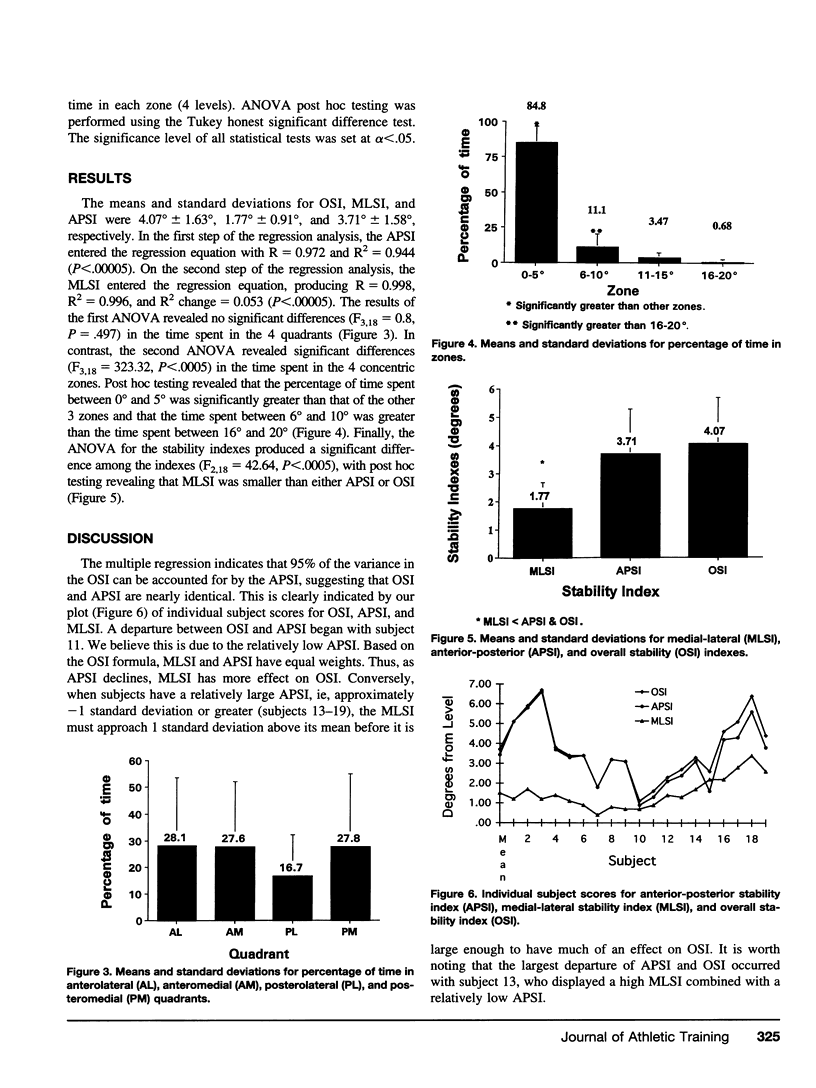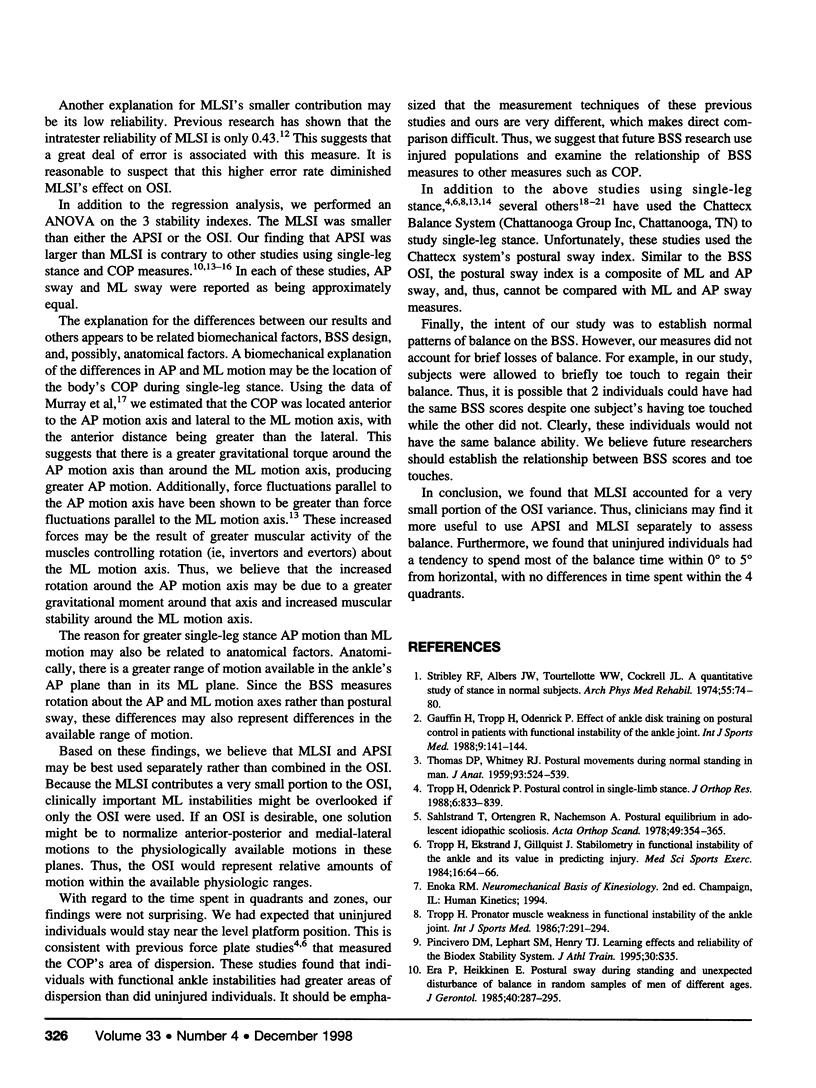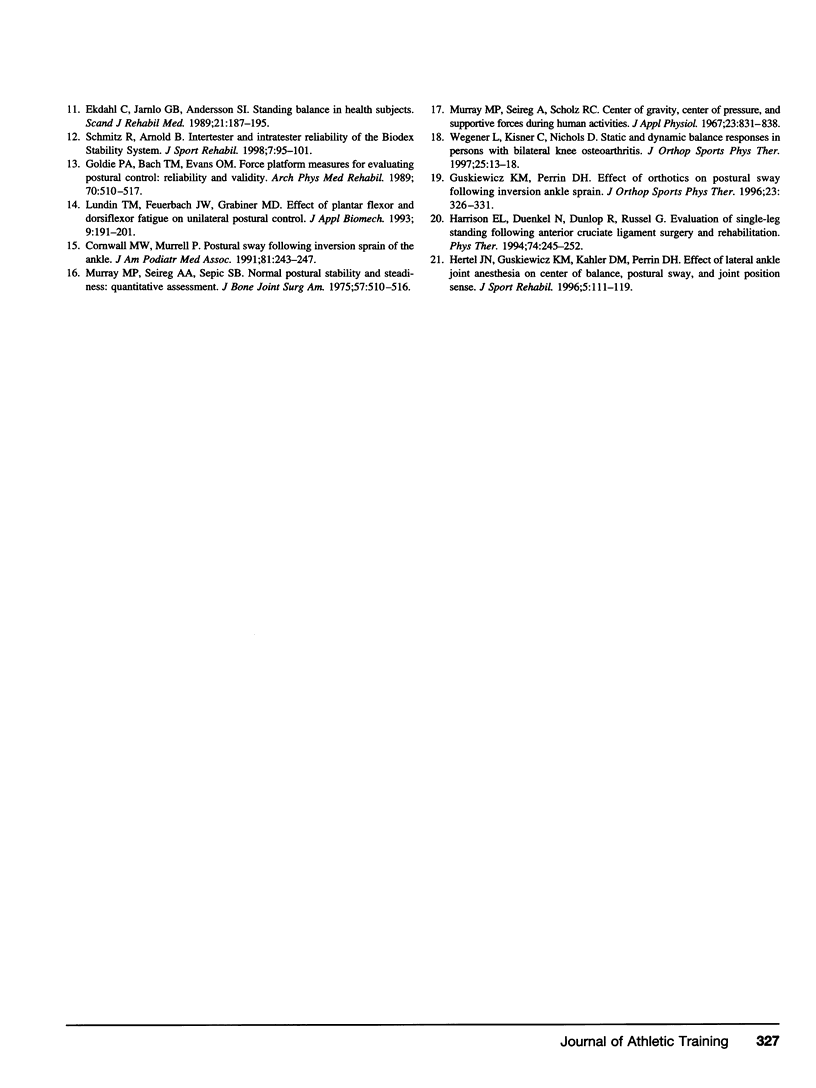Abstract
Objective:
Our purpose was to establish normal patterns and relationships of stability using the Biodex Stability System.
Design and Setting:
The design of this study used both nonexperimental and quasi-experimental methods. All testing was performed in a university sports medicine laboratory.
Subjects:
Nineteen healthy subjects (8 males, 11 females, age = 24.4 ± 4.2 years; wt = 70.5 ± 20 kg; ht = 171.2 ± 11.7 cm) with no history of lower extremity injury participated in this study.
Measurements:
For data analysis, the medial/lateral stability index (MLSI), anterior/posterior stability index (APSI), overall stability index (OSI), and time-in-balance scores were recorded.
Results:
Multiple regression revealed that APSI and MLSI significantly contributed to the OSI, with the APSI accounting for 95% of the OSI variance. Additionally, the percentage of time spent between 0° and 5° from level was significantly greater than the time spent between 6° and 10°, 11° and 15°, and 16° and 20°. Furthermore, the percentage of time spent between 6° and 10° was significantly greater than the time spent between 16° and 20°.
Conclusions:
These data suggest that uninjured individuals spent the majority of the time balanced within 0° to 5° from level and progressively less time at greater angles. Additionally, the data suggest that the OSI is very closely related to the APSI and receives a relatively small contribution from the MLSI. Because of this small contribution, if the clinician is interested in both anterior-posterior and medial-lateral motions, it may be best to use the MLSI and APSI separately rather than the OSI.
Keywords: postural control, proprioception, regression analysis
Full text
PDF




Selected References
These references are in PubMed. This may not be the complete list of references from this article.
- Cornwall M. W., Murrell P. Postural sway following inversion sprain of the ankle. J Am Podiatr Med Assoc. 1991 May;81(5):243–247. doi: 10.7547/87507315-81-5-243. [DOI] [PubMed] [Google Scholar]
- Ekdahl C., Jarnlo G. B., Andersson S. I. Standing balance in healthy subjects. Evaluation of a quantitative test battery on a force platform. Scand J Rehabil Med. 1989;21(4):187–195. [PubMed] [Google Scholar]
- Era P., Heikkinen E. Postural sway during standing and unexpected disturbance of balance in random samples of men of different ages. J Gerontol. 1985 May;40(3):287–295. doi: 10.1093/geronj/40.3.287. [DOI] [PubMed] [Google Scholar]
- Gauffin H., Tropp H., Odenrick P. Effect of ankle disk training on postural control in patients with functional instability of the ankle joint. Int J Sports Med. 1988 Apr;9(2):141–144. doi: 10.1055/s-2007-1024996. [DOI] [PubMed] [Google Scholar]
- Goldie P. A., Bach T. M., Evans O. M. Force platform measures for evaluating postural control: reliability and validity. Arch Phys Med Rehabil. 1989 Jul;70(7):510–517. [PubMed] [Google Scholar]
- Guskiewicz K. M., Perrin D. H. Effect of orthotics on postural sway following inversion ankle sprain. J Orthop Sports Phys Ther. 1996 May;23(5):326–331. doi: 10.2519/jospt.1996.23.5.326. [DOI] [PubMed] [Google Scholar]
- Harrison E. L., Duenkel N., Dunlop R., Russell G. Evaluation of single-leg standing following anterior cruciate ligament surgery and rehabilitation. Phys Ther. 1994 Mar;74(3):245–252. doi: 10.1093/ptj/74.3.245. [DOI] [PubMed] [Google Scholar]
- Murray M. P., Seireg A. A., Sepic S. B. Normal postural stability and steadiness: quantitative assessment. J Bone Joint Surg Am. 1975 Jun;57(4):510–516. [PubMed] [Google Scholar]
- Murray M. P., Seireg A., Scholz R. C. Center of gravity, center of pressure, and supportive forces during human activities. J Appl Physiol. 1967 Dec;23(6):831–838. doi: 10.1152/jappl.1967.23.6.831. [DOI] [PubMed] [Google Scholar]
- Sahlstrand T., Ortengren R., Nachemson A. Postural equilibrium in adolescent idiopathic scoliosis. Acta Orthop Scand. 1978 Aug;49(4):354–365. doi: 10.3109/17453677809050088. [DOI] [PubMed] [Google Scholar]
- Stribley R. F., Albers J. W., Tourtellotte W. W., Cockrell J. L. A quantitative study of stance in normal subjects. Arch Phys Med Rehabil. 1974 Feb;55(2):74–80. [PubMed] [Google Scholar]
- THOMAS D. P., WHITNEY R. J. Postural movements during normal standing in man. J Anat. 1959 Oct;93:524–539. [PMC free article] [PubMed] [Google Scholar]
- Tropp H., Ekstrand J., Gillquist J. Stabilometry in functional instability of the ankle and its value in predicting injury. Med Sci Sports Exerc. 1984;16(1):64–66. [PubMed] [Google Scholar]
- Tropp H., Odenrick P. Postural control in single-limb stance. J Orthop Res. 1988;6(6):833–839. doi: 10.1002/jor.1100060607. [DOI] [PubMed] [Google Scholar]
- Tropp H. Pronator muscle weakness in functional instability of the ankle joint. Int J Sports Med. 1986 Oct;7(5):291–294. doi: 10.1055/s-2008-1025777. [DOI] [PubMed] [Google Scholar]
- Wegener L., Kisner C., Nichols D. Static and dynamic balance responses in persons with bilateral knee osteoarthritis. J Orthop Sports Phys Ther. 1997 Jan;25(1):13–18. doi: 10.2519/jospt.1997.25.1.13. [DOI] [PubMed] [Google Scholar]


